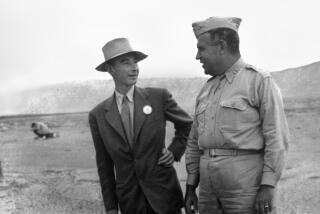Lawrence Garfinkel dies at 88; statistician helped link smoking to lung cancer
Lawrence Garfinkel, the statistician who overcame his lack of a doctoral degree and training in oncology to become one of the driving forces in demonstrating that smoking causes lung cancer, died Jan. 21 in Seattle. He was 88.
The cause of death was cardiovascular disease, according to his son Martin.
Garfinkel oversaw the training of thousands of volunteers for the American Cancer Society and helped conduct two of the largest epidemiological studies ever, enrolling more than 2.2 million men and women. The first of those studies, along with the British Doctors’ Study, played a key role in formulating the landmark 1964 surgeon general’s report on smoking and health.
“Larry Garfinkel joined the American Cancer Society as a young scientist in 1947, and for more than four decades played an instrumental role in expanding knowledge of and reducing death from smoking,” said John R. Seffrin, chief executive of the society. “His remarkable achievement is an important reminder what a tremendous impact an individual can make, and inspires all of us to continue the fight against cancer.”
Upon Garfinkel’s retirement from the society in 1989, Dr. Richard D. Klausner, then head of the National Cancer Institute, said, “Few individuals have contributed as much to our present-day knowledge about the disease consequences of smoking.”
Before 1930, lung cancer was a rare disease never encountered by most physicians. But World War I had turned many American men into smokers, and the consequences began to become apparent in the 1940s. By 1950, four separate retrospective studies had linked smoking to the disease.
In 1951, British researchers enrolled 40,000 physicians in a study that lasted more than 40 years. At the same time, the American Cancer Society’s Dr. E. Cuyler Hammond and Dr. Daniel Horn enrolled 187,783 white males in nine states in a similar study.
Garfinkel, who had joined the society as a statistician in 1947, was directly responsible for the fieldwork in the study, training the thousands of volunteers who collected the data. The two studies clearly showed that smoking could directly cause lung cancer, but many refused to accept the findings.
When the society began its Cancer Prevention Study I in 1959, Garfinkel was promoted to co-principal investigator. In addition to training volunteers, he took an integral role in analyzing the data from 1 million people and publishing the results, and he and Hammond co-wrote the 1961 paper, “Smoking Habits of Men and Women,” that reported the first results from the study.
When Hammond retired in 1979, Garfinkel took over his position and organized Cancer Prevention Study II, which included 1.2 million participants from all 50 states and Puerto Rico. It remains the largest epidemiological study of its kind ever attempted.
In 1988, he and Dr. Steve Stellman, now at Columbia University, reported the shocking finding that the mortality rate from lung cancer in female smokers was five times as high in the new study as it had been in the earlier one. Nonsmoking women showed no increase in lung cancer -- convincing evidence that lung cancer was primarily a disease of smokers.
In later studies, Garfinkel also showed a link from air pollution and obesity to cancer.
Lawrence Garfinkel was born in Manhattan on Jan. 11, 1922, to Polish immigrants and raised in the South Bronx. He graduated high school at 15 and enrolled at City College of New York, working in the garment district by day and attending classes at night, studying on the subway. His education was interrupted when he joined the Army infantry during World War II. Seriously wounded by shrapnel in France in August 1944, he recuperated for months before returning to school and work.
Because he was working, it took him 10 years to earn his bachelor’s degree in statistics from City College of New York. He earned a master’s in statistics from Columbia University before joining the cancer society.
He published more than 100 scientific reports during his career. Even after retiring, he continued to volunteer for the cancer society and taught biostatistics at New York University’s dental school.
“He was truly a giant in the field of epidemiology,” Stellman said. “He was also kind and modest, and a wonderful collaborator who cared deeply about the volunteers and professional staff that made ACS a unique research organization.”
Garfinkel moved to Seattle in 2004 to be near his extended family.
His wife, Celia, died in 1993. He is survived by two sons, Martin of Seattle and Herb of San Francisco; two brothers, Harold of Margate, Fla., and Melvin of Farmington, Conn.; and two grandchildren.






